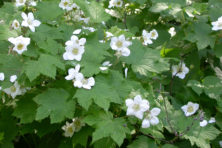The Tart, Tasty Thimbleberry
- Share
- Tweet
- Pin
- Share
Charlotte and I were pleasantly surprised a few days ago, while doing the weekly checking of our 50-box Eastern Bluebird trail, to see many wild Blackberry canes in full flower at various sites. Immediately thoughts came to mind of one of our favorite homemade jellies, Blackberry jelly, and the fact that our supply has long been gone due to poor crops in the past few years. Hopefully our luck will change for the better this summer. This berry, considered to be genuine ambrosia by nearly all people as well as many wild creatures, is known to be America’s most valuable wild fruit.
The Rubus (RUE-bus) genus, named after the Roman term “ruber,” meaning red, includes 205 species of a small number of Raspberries and many species of Blackberries in the eighth edition of Gray’s Manual of Botany, an excellent reference I’ve used for the past 54 years. Dr. Albert Fuller, long-time curator of botany at the Milwaukee Public Museum, a founder of the Ridges Sanctuary at Baileys Harbor, and my most valuable and inspirational wild plant mentor during the mid-1960s, worked at better identification of the wild Blackberries of Wisconsin during his retirement years, an extremely difficult genus to study.
Most of the Blackberries are born on brambles, which warrant one’s utmost respect. Being in the rose family, the flowers have five petals that usually are white. The black, shiny, sweet berry consists of numerous tiny drupelets, each with a seed, adhering to an edible juicy core. Canes are usually upright or arching and the leaves are greening beneath.
How I cherish the memories of going years ago with my dad and two older brothers, Leo and Ivan, to a place north of Mountain, WI to pick wild Blackberries. Dishpans, soup kettles, pails, all were brimming, and the trunk of our 1937 Chevrolet was filled with the toothsome fruit when we arrived home late Sunday night. By the way, our tongues were stained purple from all the berries we had eaten that day as we picked. My mouth waters just thinking about the many jars of Blackberries, Blackberry jam and jelly my mother put up then.
Another member of the large Rubus genus, the Thimbleberry, Rubus parviflorus (par-vi-FLO-rus), became a favorite of mine around 45 years ago following a bird banding convention trip to the UP of Michigan with Harold Wilson. The names of berries can be quite localized. As a result you may find a dozen or more plants called Thimbleberries. The one I refer to grows near the northeastern shore of Door County, generally north of Sturgeon Bay on the Lake Michigan side of the peninsula, extending onto Washington Island, Rock Island, the Keweenaw Peninsula, Isle Royale, and northward and westward into the mountains.
Constant summer coolness and moisture very near the water are two of its important requirements. One reaches a specific elevation in, for example the Rocky Mountain region, where the moisture and lower temperatures are just right, and there you will find Thimbleberries doing very well.
Leaves of this marvelous plant are unusually large, velvety, and appear to have come from some kind of maple tree. What is so pleasant about picking the fruit is the fact that the canes are smooth and have no thorns. The extremely tart, small-seeded fruits flatten when picked, usually ripen in early August and can be made into an extraordinarily delectable jam.
Our friend of years ago, Miss Emma Toft, who was a master at picking these unusual berries and transforming them into superb jam, offered us the following advice. First line your pail with a few fresh Thimbleberry leaves and try to pick the berries clean. They are too fragile and difficult to pick over before making the jam. Combine one cup of sugar with each cup of fruit, bring the mixture to a boil and immediately turn off the heat. Ladle into sterilized jars and you have, as Miss Emma would have described this delicacy, “the jam with the pine flavor,” the world’s finest.
Be sure to obtain permission from property owners to pick these luscious berries, and because the fruit flattens as you put them into your container, don’t expect to have your pail fill up too rapidly! By the way, all people who own property along Lake Michigan, for example north of Sturgeon Bay, are not necessarily fond of the highly aggressive nature of Thimbleberry canes. Another point to bear in mind is that removing anything, such as fruit, nuts, mushrooms, etc., from State Natural Areas such as Toft Point, is prohibited. Our state parks do allow you to pick wild foods.
The species name of the Thimbleberry, parviflorus, means “small-flowered” and is rather poorly chosen. Actually this plant’s blossoms can be quite large, nearly the size of a silver dollar. This year, as has happened with many wild plants, flowering has been at least a week to 10 days earlier than usual. I photographed some fully opened blossoms in early June. Surely plenty will remain in good flower in shady areas in the third week of this month. Regular rainfall will be needed in order for a good crop of the berries to form and ripen. Now is the time we like to scout the areas where we’ll try to pick enough Thimbleberries this early August for making a dozen or more half-pint jars of jam.
Years back we were introduced to an unusually excellent campfire treat at Toft Point when that area, rich with Thimbleberries, was still owned by the Toft family. Friends who were camping there had a pound cake that they sliced into quarter-inch-thick pieces. Half of each “sandwich” was spread with Thimbleberry jam (which they had purchased from Miss Emma), followed by a few thin squares of chocolate, then complimented with a couple of freshly toasted marshmallows and finally completed with the remaining slice of pound cake put into place. Believe me this produced an award-winning, mouth-watering dessert fit for visiting dignitaries to the cool, humid, lake-bordering, Thimbleberry-rich northern forest!


